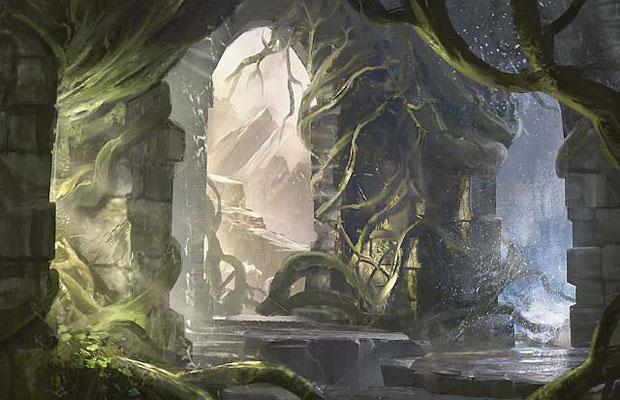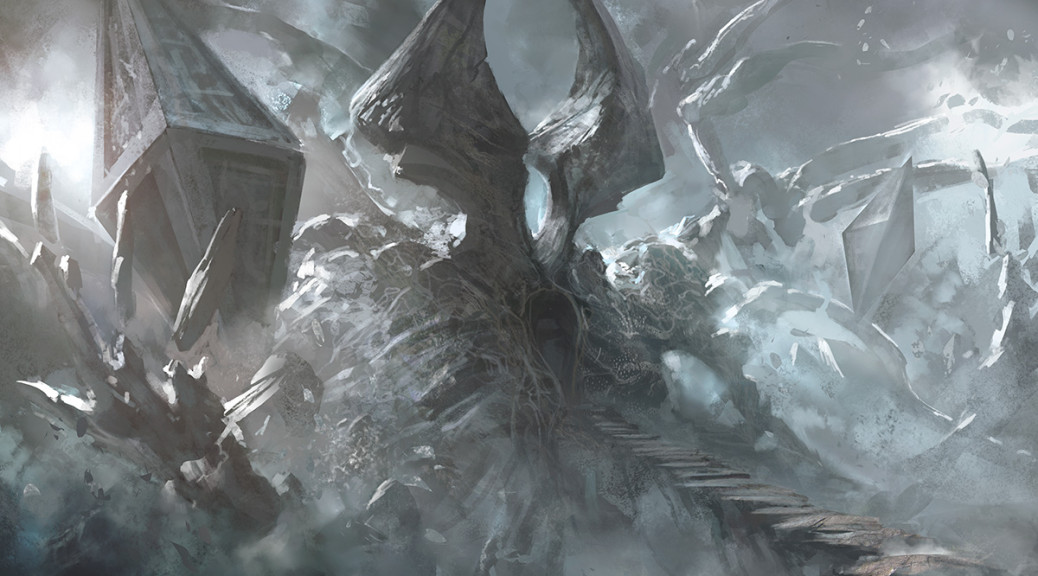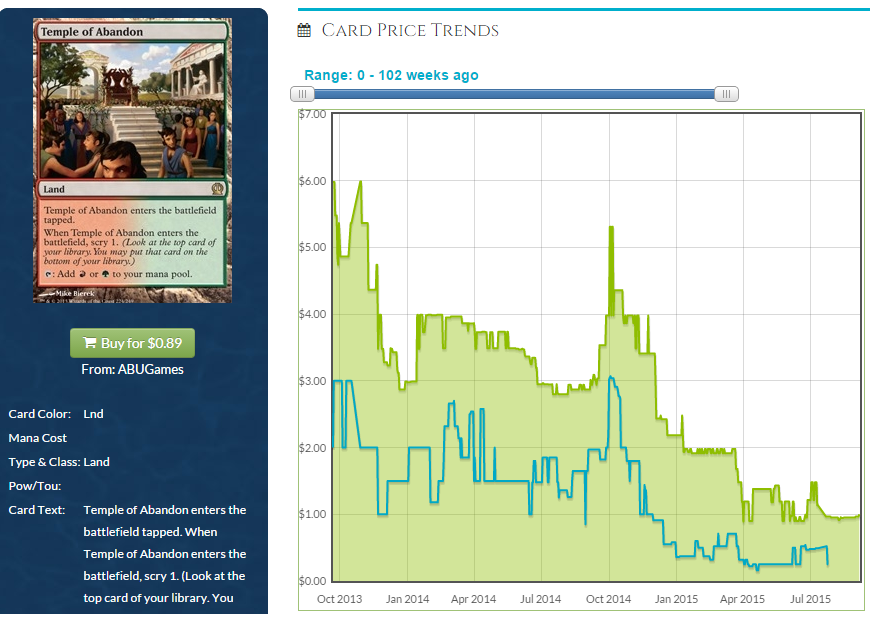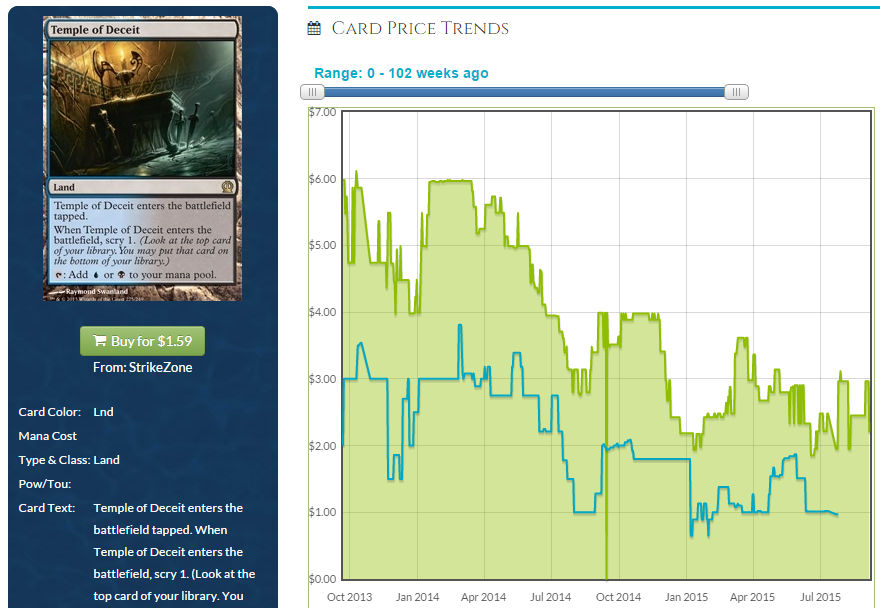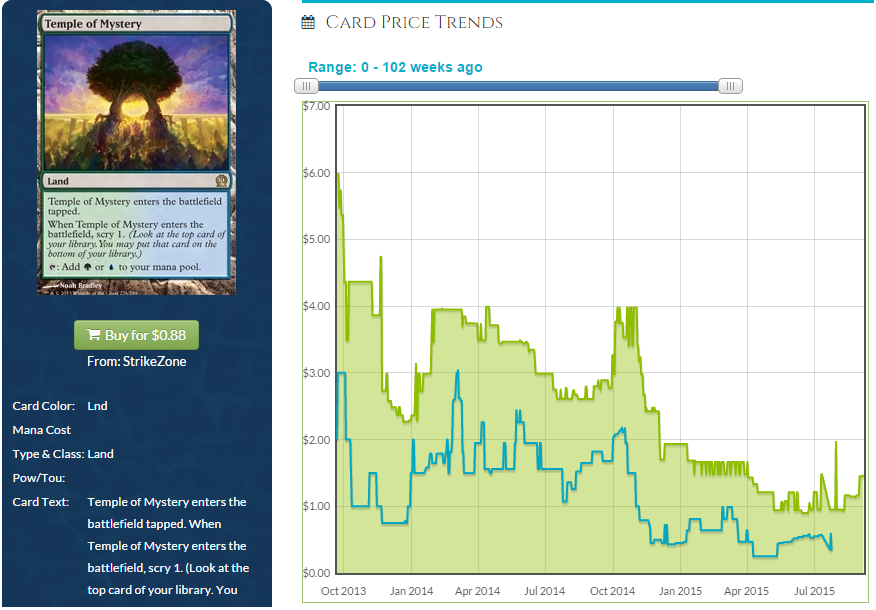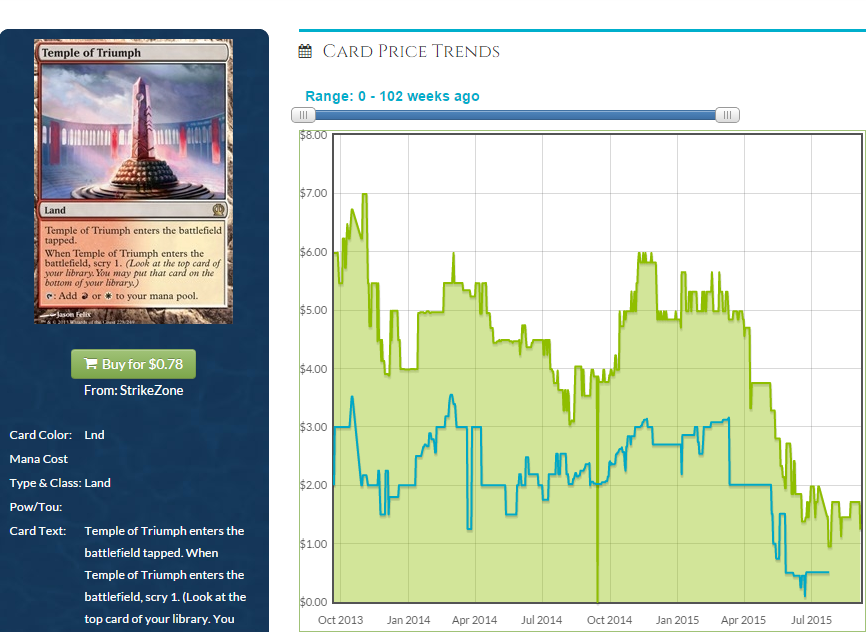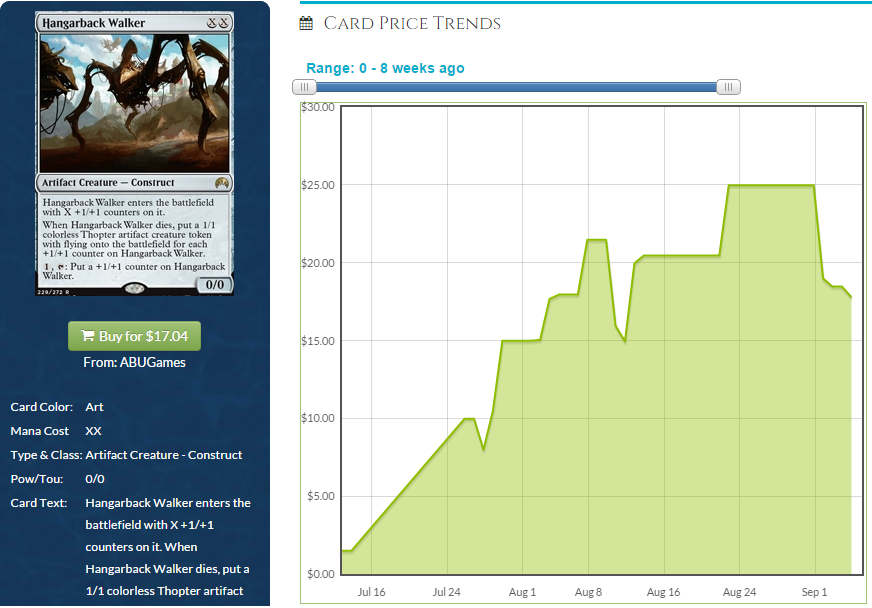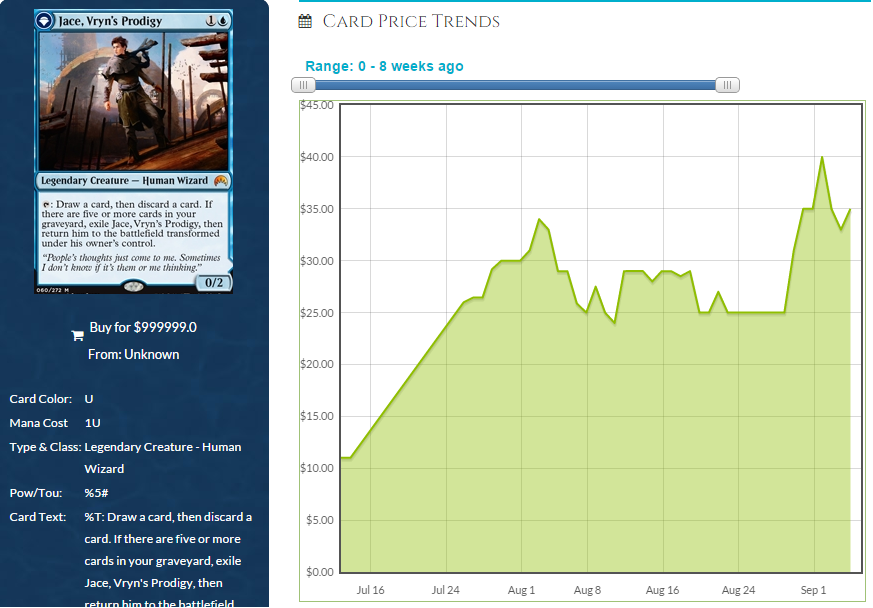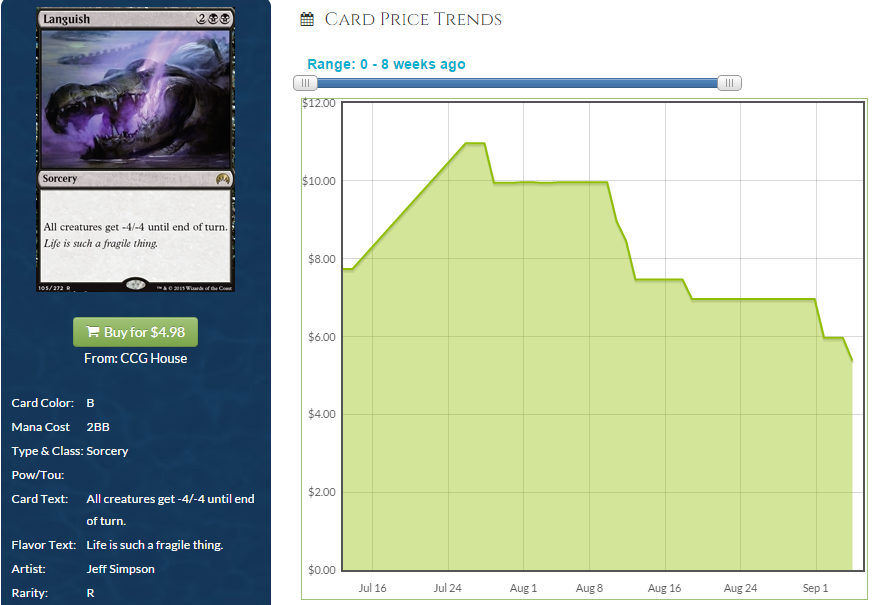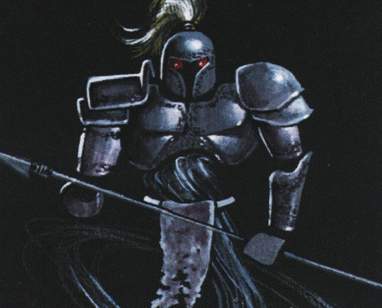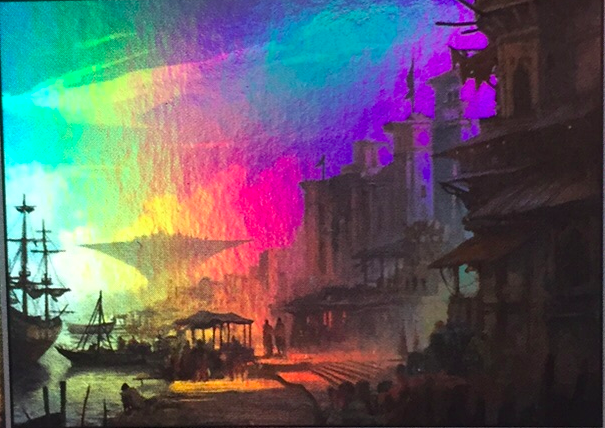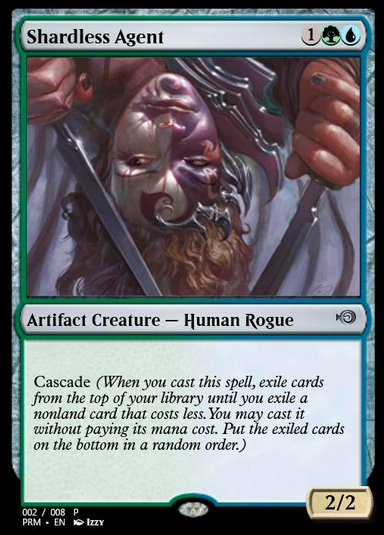I had hoped Battle for Zendikar spoilers would give me a clear signal this week. We got a lot of cool cards spoiled, but nothing really sticks out, and I think we need to avoid a repeat of last week. I used a card I’m not excited about reanimating to frame a discussion about reanimation cards, which felt forced to me and resulted in an article a lot of you weren’t super happy with the entire way through. I mean, granted, there were good points about cards like Debtors’ Knell, but in general, you’re not reanimating fatties in EDH as much as you are cycling value creatures. You don’t want a full yard, begging to get Bojuka Bogged or Tormod’s Crypted. You want to keep bringing back Karmic Guide and Eternal Witness like a cheater. I didn’t like writing or reading the comments on my last article.
Grinder Finance – The Battle for Zendikar… Expeditions

So you’ve seen this beauty right? Noah Bradley (one of my personal favorite artists) has some new lands in the next set… and a half? This Steam Vents art is being used for the “full” art lands in Zendikar Expeditions.
What is Zendikar Expeditions?
Let’s start out and dispel anything myths about this set. I see too much misinformation being passed around.
- Zendikar Expeditions (henceforth abbreviated as ZE), is a set of 45 cards that is not part of Battle for Zendikar or Oath of the Gatewatch sets but will be found in their booster packs.
- There you can open 25 of the ZE cards in Battle for Zendikar. These 25 cards are the 10 shock lands (Steam Vents, Godless Shrine, Overgrown Tomb, etc), the 10 fetch lands (Scalding Tarn, Marsh Flats, Polluted Delta, etc), and the 5 new Battle for Zendikar dual lands.
- We do not have any confirmation on what the next 20 cards, available in Oath of the Gatewatch, will be. They may not even be lands. There is no information available about them outside of the fact that there are 20. (Note: This is incorrect, Matt Tilling in the comments linked the correction – here – They are all lands)
- The rarity of a ZE card is approximately slightly lower than the rate of opening a foil Mythic rare. This is very roughly approximately 1 per case (6 boxes) of Battle for Zendikar.
- ZE cards are NOT legal in Standard. They ARE legal in limited if you open them in a draft or a sealed pool.
- ZE cards are not able to be redeemed on Magic Online, but they will be available to be opened.
- ZE cards will be available throughout the entire print cycle of Battle for Zendikar. This is unlike the treasures found in original Zendikar packs which were supposedly only available in the first print run.
- ZE cards will be expensive.
Well now that we got that out of the way, what does that mean for players? Well, a lot. It means pre-ordering almost any card in Battle for Zendikar is a losing proposition. It’s clear people will open obscene amounts of this product and have far more copies of most cards than they will ever need. It also means that the price of cards from this set will quickly bottom out. If you read my article a few weeks ago, Grinder Finance – Winter is Coming, you will know how I feel about card prices for the fall set. Battle for Zendikar is going to continue the tradition of the fall set being the “most opened set of all time” and more because of Zendikar Expeditions. If people are really hyped to buy cases of product to ensure opening a Zendikar Expedition card then it will drive the price of opened product down.
What’s the plan for this pre-order season? Well it’s pretty simple. Don’t buy anything you don’t plan on using in the first week of Battle for Zendikar Standard. Don’t buy all of the lands. Don’t buy the sweet new Omnath for your EDH deck. Don’t buy bulk rares and hope they spike. There will be cards that go up. It’s inevitable that some things will spike the weekend of the Pro Tour. However, the reality is if you can wait until late December, you will find that card prices absolutely plummet. Right now most websites have the new Battle for Zendikar dual lands pre-ordering for about $40 for a playset. These duals might be a little stronger than Theros block scry lands, but even the most expensive scry lands were only $8-10 at their peak. The scry lands that were in Theros were always the least expensive because of the sheer number that were opened.
All of the temples, regardless of how playable they were, exhibited the same dip at the end of December. You could have saved 30% to 50% on these lands if you waited until their low points to buy them. In fact, only one of the lands even went up from it’s pre-order price after release. I expect a similar thing to happen with the Battle for Zendikar dual lands.
There will probably be one that increases a little in price as it is in top decks, but the rest will likely see a steady decrease in price until the new year.
Battle for Zendikar Mythic Rares
Don’t buy them now unless you absolutely need them. I can’t imagine a world where Ulamog, the Ceaseless Hunger continues to stay at or above it’s current $20-25 price tag. Look at what happened to Khans of Tarkir mythic rares.
Pre-order prices were conservative. Cards were then released. The mythic rares that got played on the Pro Tour saw a huge spike and then ever since they have just been on a downward spiral. Do you know what the top 10 most expensive cards are in Khans of Tarkir? Polluted Delta, Flooded Strand, Wooded Foothills, Bloodstained Mire, Windswept Heath, See the Unwritten, Sorin Solemn Visitor, Dig Through Time, Anafenza the Foremost, and Sarkhan the Dragonspeaker. You know what’s importantly missing from this list? Cards that see a ton of play in Standard! Siege Rhino isn’t even the 11th most expensive card! Monastery Swiftspear beats out almost every Mythic and Rare in the set because of it’s eternal play.
With Battle for Zendikar looking to be the world heavy weight champion of the “most opened set in Magic history”, I don’t like pre-ordering any of the cards. Right now, I think it is time to shore up your collection with cards from Magic Origins.
With these two cards seeing play in Legacy and Modern, there is likely not going to a reprieve for their price point. Jace might not see a ton of Standard play but his pack foil is as of this writing, a minimum of $80 on TCG player. That’s a sign there is strong eternal demand from players who intend to keep him in their deck long term. I know I called him a sell a few weeks ago, but I did not see him becoming a force in Eternal formats. Eventually it’s time to tap out and realize that this is clearly not a hype train. Sustained growth for 2 months is a sign of a card poised to carry a lot of the weight of a set.
Hangarback Walker is the single most underrated card in the set on release. It’s deceptively flexible and people were too worried about over paying for all of it’s effects. What’s clear is this is no Chronomaton. With it showing up in Vintage shops, Legacy Mud, and Modern’s Affinity, it’s hard to point to a reason this won’t be a twenty dollar bill for the foreseeable future. With people scraping every penny they can find together for Battle for Zendikar, it is safe to say that supply on Magic Origins cards is near it’s peak. I can’t see a reason to wait to buy in at this point.
After coming down from it’s brief $11 price point, Languish is a card to keep an eye on. If we see a lot of Allies that have less than 4 toughness, this may quickly find itself a home in many decks. It also does a pretty decent job cleaning up Hangarback Walker scraps. I don’t know if it will drop more before the release of Battle for Zendikar but it’s important to keep it on your radar. If it starts to turn after the first week of post Zendikar SCG opens, you may want to buy in.
PROTRADER: Credit Is King – Part 2
It’s working. I can’t believe it’s actually working.
Since writing my “Credit is King” article a few weeks ago, I have managed to turn about $170 into over $500 in store credit. This growth is a result of nothing more than taking trade-in credit from one vendor to purchase cards that a different vendor has a better buy price on (including credit). At first the task seemed daunting and improbabe, but after a half a dozen cycles across three different retailers, I can confirm that this strategy is 100% effective.
At least for now…more on that later.
But before I dive into the cautions of this approach, I first want to share some high level observations on the three vendors I use most frequently for this credit experiment: Star City Games, Card Kingdom, and ABU Games. By understanding a few valuable rules of thumb and observations, we can begin to piece together how this credit experiment has been so successful to date.
The rest of this content is only visible to ProTrader members.
To learn how ProTrader can benefit YOU, click here to watch our short video.
Catching up: Battle for Zendikar, Judge Promos Revealed and more!
A Much Needed Reprint
This weekend, we got a sneak preview of one of the upcoming Judge Gift Program promos that will be handed out. This is one of the first shots we received of one of the promos:
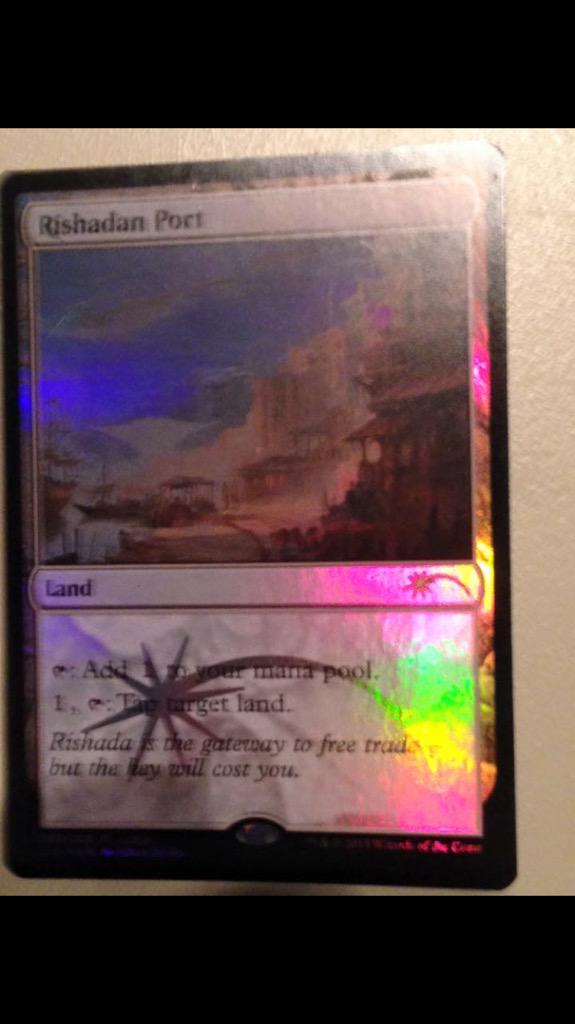
That’s right, Rishadan Port is finally getting a much needed reprint! Rishadan Port was all but confirmed in this Tweeted picture by @TokyoMTG and this is definitely a reprint that I and many players have been waiting for.
Historically, Rishadan Port’s price has been fairly stable at around $30 since it pretty much always saw play in the Legacy Goblins deck. This was the case for several years, before decks Death and Taxes and Lands became forces in their own rights in Legacy. Death and Taxes was better able to use the mana denial effect along with all of the tax and denial creatures that go introduced like Thalia, Spirit of the Labyrinth, and most recently Vryn Wingmare. After Legacy cards started spiking around the time of the Survival of the Fittest frenzy (thanks Vengevine), Port was one of the cards that started spiking along with original dual lands, Force of Will, and other Legacy staples. Since then, the card has creeped and spiked its way up to $100 per copy – which is pretty crazy for a card that only sees play in Death and Taxes, Goblin, and Lands, which only makes up a small portion of the Legacy metagame. With this reprint, the non-foil price should come down (though by how much, I’m not sure since Judge Foils are harder to get ahold of these days – honestly maybe only 10-20% at least initially) since more copies are about to enter the market.
What is also great about this reprint is that we finally get a foil version of the card that isn’t $500+. Masque’s foils are soooo rare, and with players needing four copies to foil out Legacy decks the supply quickly dries up for each person that wants to complete a playset. Now, there is a fine replacement out there (which also has amazing artwork, in my opinion) that will be the same price as the non-foil copy! This is definitely a reprint that has been a long time coming, so kudos to Wizards for finally getting this one out to market.
Also, more Judge Promos were revealed by @ahalavais.
So here, we’re also getting Temporal Manipulation and Shardless Agent, both of which previously didn’t exist in foil! Just like Rishadan Port, Temporal Manipulation sorely needed a reprint – the card was previously over $100 when its equivalent Time Warp was only 1/10th of that price. It was ten times the price only due to scarcity. Now, that price should be significantly reduced since Temporal Manipulation only sees play in the Commander format.
While Shardless Agent didn’t necessarily have to be reprinted, I think it was still a fine choice to include as a Judge Promo. There isn’t any way to easily slide it into regular set, so Judge Foil printings are the only easy way of getting foil copies out there for Legacy players who play Shardless Sultai. I’m actually not sure where the price of this foil is going to wind up – it’s going to be more expensive than the regular, non-foil copies but exactly how much more expensive? Two times? Three times? Four or Five times!? (probably not). The final price, after copies have saturated the market, will probably settle in the 2x-3x range since Legacy players want foil copies and this is the only foil that is out there.
The Judge Foil spoilers so far are a pleasant surprise to us after the Damnation fiasco which was a lose-lose for everyone. It was lose for casuals, since they wanted a Damnation reprint but making a Judge Foil still made it unaffordable for the vast majority of players. It was a lose for collectors and more serious Commander / Eternal players, because it devalued Planar Chaos foils since now there is a new saturation of foil Damnations out in the market with the exact same art. Plus, they also printed Wasteland again as a Judge Promo in that same wave, so that further added to the “Why bother?” many players were thinking when that particular wave of Judge promos was released earlier this year.
I really think Wizards nailed these promos this time around. They did their market research before creating this batch of Judge Foils because all of them revealed so far have been spot on to what the market needs. If only all Judge Promos could follow similarly in the future…
In Other News
@Rose0fthorns gave us two gems of insight over the past week. The first is that (obviously) Shaman of Forgotten Ways has spiked hard. Going from $2.50 to $9 is some serious gains, and I agree with his advice to get out now while the gettin’s good. There is a huge difference between two (Rattleclaw Mystic) and three mana, especially when it comes to creatures that enable you to ramp up into bigger threats. Plus, the Shaman’s mana can only be used on creatures – something that may not seem like a drawback at first, but then you think about spells like Crater’s Claws and that extra two mana could mean the difference between ending the game on a critical turn or having to pass without having enough mana to Fireball your opponent’s face.
I feel like See the Unwritten has much more potential than Shaman to see significant Standard play. Mostly because with See the Unwritten, you’re getting a threat that needs to be dealt with while the Shaman’s ultimate isn’t coming online until the end game and you can easily predict when your opponent is setting up to activate the Formidable. The Pro’s will try to make StU work again – Jon Finkel was casting this bad boy on camera last time, and I expect to see it on camera again since Eldrazi are going to be so awesome to get off a pseudo-Tooth and Nail.
Second, we should start taking a closer look at Rise of the Eldrazi for more opportunities for pickups. Spawnsire of Ulamog was a fine example, and getting on foils before they spiked was a good call. There are plenty of other targets out there, including the recently reprinted Emrakul and Kozilek in Modern Masters 2015, that should also see nice gains over the next year. I highly suggest you check out DJ’s article from last week as it is a good primer of what cards are starting trend and what you should be looking out for if you’re trying to find the next casual hit that synergizes with Eldrazi.
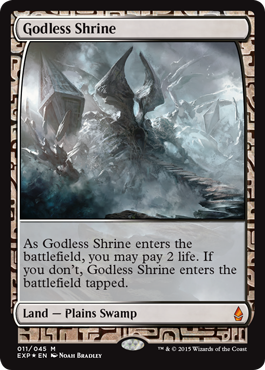

Also, I would be remiss not to mention that @GoingMadlem released a wonderful piece describing what we can expect with the resurfacing of the “Priceless Treasures” Expeditions that are being distributed in packs of Battle for Zendikar. While I encourage you to read the article, the core theme is that Wizards needs to be careful releasing extremely desirable promos like these in regular MTG sets because it can have lasting and detrimental effects on the secondary market if done incorrectly (cough Yugioh cough).
Finally, @shormtg wrote a great Reddit post on Friday about the macro growth of Magic as a whole. It is a compelling read which tries to answer the essential question “Is Magic in a bubble?.” Shormtg argues that we aren’t in the bubble yet, using the example of the difference between comics and Magic in terms of exchange. We have multiple exchanges, like TCGPlayer and PucaTrade, to realize value with Magic cards than we do with comics and other antiques.
Now, another interesting thing about Magic in regards to bubbles is that there is more than one way to make money from the game – the latest example of this being the Art of Zendikar book that Wizards is releasing to accompany the Battle for Zendikar set. While this is one of many ways to get existing players to spend more money on the game they love and falls into Point Two of the posting, I think it is important that we’re starting to see products like this because it tells us that Wizards is thinking outside the box and will pursue multiple alternative routes for generating dollars than simply releasing more and more card based products every year. Though many of us roll our eyes at these products as “cash grabs”, Wizards/Hasbro are a company like any other – and if profits aren’t coming in as expected than budgets are cut and its going to be felt by everyone that plays. The macro economics of Magic are definitely something to consider as we move forward – like Sig always likes to say, it is definitely a viable strategy to make sure your primary collection value is tied up in the Reserve List.
